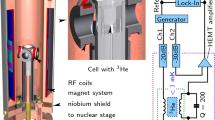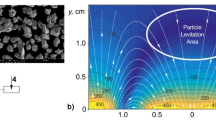Abstract
Can vibrations act in space as an artificial gravity? We investigate here the role of high frequency vibrations to accelerate the dynamics of phase transition of gas and liquid in space. Hydrogen is studied near its critical point (Tc =33 K). Gravity effects are compensated in a high magnetic field gradient as provided by a 10 T superconducting coil. The experiments are performed in the temperature range [0.08 − 1.1] mK from Tc, at critical and off-critical densities. The pattern shows up as interconnected gas-liquid domains or bubbles. When the domain size becomes larger than the viscous boundary layer, growth is accelerated and the domains eventually elongate in the direction perpendicular to the vibration (interconnected pattern case) or align in periodic planes in the same direction perpendicular to vibration (bubble pattern case). We explain the experimental findings by the presence of inertial velocity gradients between the vapor and liquid domains, which favor coalescence and fast domain growth.
Similar content being viewed by others
References
Onuki, A.: Phase Transition Dynamics. Cambridge University Press, Cambridge, (2002).
Wunenburger, R., Chatain, D., Garrabos, Y., andBeysens, D.: Magnetic compensation of gravity forces in (p-) Hydrogen near its critical point; application to weightlessness conditions. Phys. Rev.E, vol. 62, p. 460 (2000).
Nikolayev, V. S., Beysens, D., andGuenoun, P.: New hydrodynamic mechanism for drop coarsening. Phys. Rev. Lett., vol. 76, p. 3144 (1996);Beysens, D., and Garrabos, Y.: The phase transition of gas and liquids. Physica A, vol. 281, p. 361 (2000) and Refs. therein.
Diller, D.E.: J. Chem. Phys. 42, 2089–2098 (1965). From an extrapolation at Tc of the data.
Siggia, E. D.: Phys. Rev. A 20, 595–605 (1979).
Zappoli, B., Bailly, D., Garrabos, Y., Le Neindre, B., Guenoun, P., andBeysens, D.: Anomalous heat transport by the piston effect in supercritical fluids under zero gravity. Phys. Rev. A, vol. 41, p. 2264 (1990).
Landau, L.D., andLifshitz, E.M.: Fluid Mechanics. Pergamon Press, Elmsford, New York, (1975).
Stanley, H. E.: Introduction to phase transitions and critical point phenomena. Oxford University Press, Oxford, (1971).
Moldover, M.R.: Phys. Rev. A 31, 1022–1033 (1985).
Baumberger, T.: Ph. D. thesis, University Paris XI, 1992, p.129
Lyubimov, D.V., Lyubimova, T.P., and Shklyaev, S.V.: Behaviour of a Drop (Bubble) in a Pulsating Flow near Vibrating Rigid Surface, in 1st International Symposium on Microgravity Research & Applications in Physical Sciences and Biotechnology, Sorrento (Italy), Sept. 10–15 2000, edited by ESA-SP, Conference Proceedings, vol. 454, p. 879 (2001).
Wunenburger, R., Carrier, V., andGarrabos, Y.: Periodic order induced by horizontal vibrations in a two-dimensional assembly of heavy beads in water. Phys. of Fluids 14, 2350–2359, (2002).
Author information
Authors and Affiliations
Rights and permissions
About this article
Cite this article
Beysens, D., Chatain, D., Evesque, P. et al. Dynamics of phase transition in H2 under high frequency vibrations. Microgravity sci. Technol. 16, 274–279 (2005). https://doi.org/10.1007/BF02945990
Issue Date:
DOI: https://doi.org/10.1007/BF02945990




